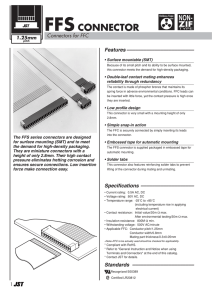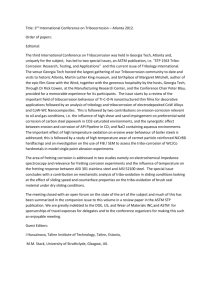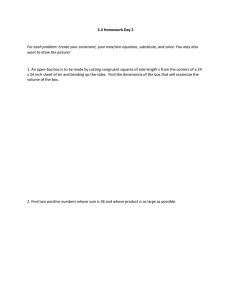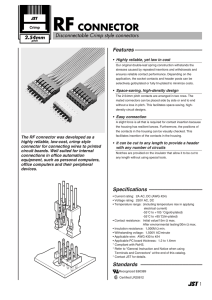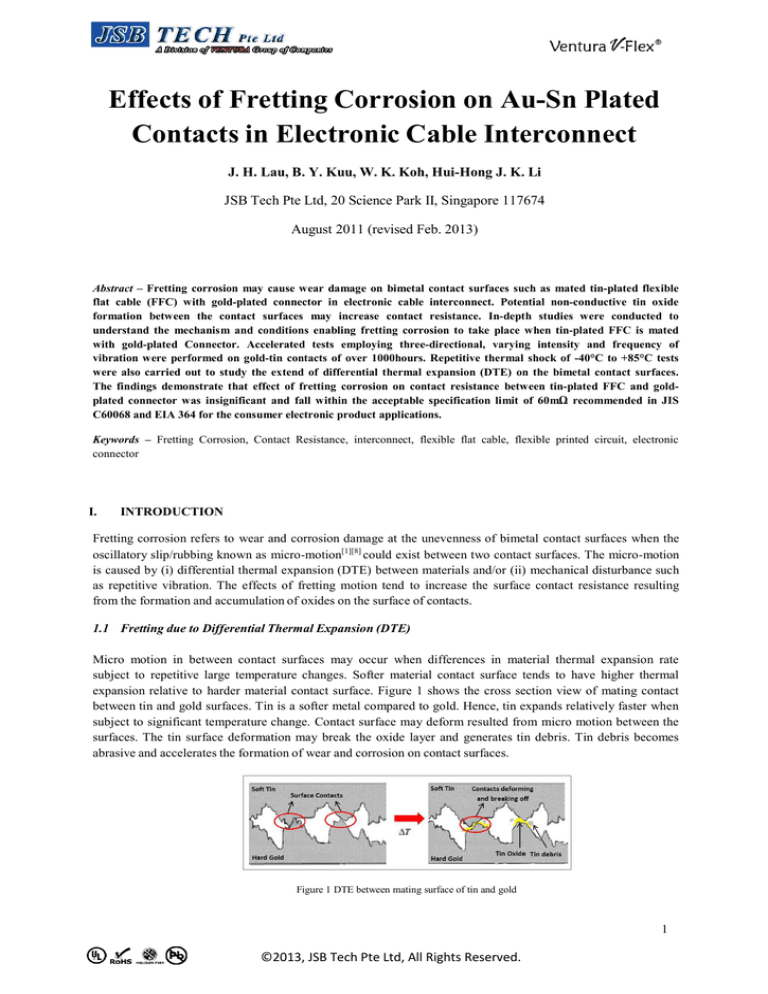
Effects of Fretting Corrosion on Au-Sn Plated
Contacts in Electronic Cable Interconnect
J. H. Lau, B. Y. Kuu, W. K. Koh, Hui-Hong J. K. Li
JSB Tech Pte Ltd, 20 Science Park II, Singapore 117674
August 2011 (revised Feb. 2013)
Abstract – Fretting corrosion may cause wear damage on bimetal contact surfaces such as mated tin-plated flexible
flat cable (FFC) with gold-plated connector in electronic cable interconnect. Potential non-conductive tin oxide
formation between the contact surfaces may increase contact resistance. In-depth studies were conducted to
understand the mechanism and conditions enabling fretting corrosion to take place when tin-plated FFC is mated
with gold-plated Connector. Accelerated tests employing three-directional, varying intensity and frequency of
vibration were performed on gold-tin contacts of over 1000hours. Repetitive thermal shock of -40°C to +85°C tests
were also carried out to study the extend of differential thermal expansion (DTE) on the bimetal contact surfaces.
The findings demonstrate that effect of fretting corrosion on contact resistance between tin-plated FFC and goldplated connector was insignificant and fall within the acceptable specification limit of 60mΩ recommended in JIS
C60068 and EIA 364 for the consumer electronic product applications.
Keywords – Fretting Corrosion, Contact Resistance, interconnect, flexible flat cable, flexible printed circuit, electronic
connector
I.
INTRODUCTION
Fretting corrosion refers to wear and corrosion damage at the unevenness of bimetal contact surfaces when the
oscillatory slip/rubbing known as micro-motion[1][8] could exist between two contact surfaces. The micro-motion
is caused by (i) differential thermal expansion (DTE) between materials and/or (ii) mechanical disturbance such
as repetitive vibration. The effects of fretting motion tend to increase the surface contact resistance resulting
from the formation and accumulation of oxides on the surface of contacts.
1.1 Fretting due to Differential Thermal Expansion (DTE)
Micro motion in between contact surfaces may occur when differences in material thermal expansion rate
subject to repetitive large temperature changes. Softer material contact surface tends to have higher thermal
expansion relative to harder material contact surface. Figure 1 shows the cross section view of mating contact
between tin and gold surfaces. Tin is a softer metal compared to gold. Hence, tin expands relatively faster when
subject to significant temperature change. Contact surface may deform resulted from micro motion between the
surfaces. The tin surface deformation may break the oxide layer and generates tin debris. Tin debris becomes
abrasive and accelerates the formation of wear and corrosion on contact surfaces.
Figure 1 DTE between mating surface of tin and gold
1
©2013, JSB Tech Pte Ltd, All Rights Reserved.
1.2 Fretting due to Mechanical Disturbance
The mechanism of mechanical disturbance happens through repetitive motion of vibration at high intensity and
frequency. Typical sources of vibrations are engine, electric motors and mechanical movements that resulting in
shocks and impacts. Vibration testing classifies various industries into four categories [1] as shown in Figure 2
below.
Figure 2 Classification of Vibration Testing Applications
The aerospace, defense and commercial aircraft applications are categorized as high vibration and shock stress
due to the use of large engines that generate large shock amplitude at higher frequency of repetitive vibration in
wide operating temperature changes of -40° to +120°C in harsh environment. However, applications for
electronic interconnect in consumer electronics and automotive products, such as AV system, inkjet printer,
GPS, car audio and TV are not category of high vibratory or shock stress.
Electric motors used for general consumer electronic products and system applications are relatively much
smaller in size, generates smaller amplitude/displacement and lower frequency of vibration. The narrower
operating temperature range of -20° to +80°C also reduces the potential risk of fretting corrosion due to
differential thermal expansion.
1.3 Mechanism of Fretting
When mating connector with flexible flat cable, the contact surface interface contains „peaks‟ and „sloping hills‟
at microscopic scale as shown in Figure 3. These uneven contact points are known as asperities. When the
surfaces rub against each other due to vibration and/or differential thermal expansion, these asperities collide
against with the opposite surface that may cause fretting motion.
Figure 3 Asperities of two mating surfaces on microscopic view
There are two conditions where fretting may take place in mating connector with FFC. The first situation is that
both plated surfaces have different hardness. The harder surface would cause the softer surface flaking (i.e.
metal loss) and wears as contact pressure causes the asperities to break off. For example, when gold-plated
connector contacts is mated with tin-plated FFC, metal loss and wear may happen at softer tin surface and
produce tin debris that forms an insulating film of tin oxide as highlighted in Figure 4.
2
©2013, JSB Tech Pte Ltd, All Rights Reserved.
Figure 4 Typical Top View of FFC Surface (after FFC is pulled out from Connector). Mag: 500X
The second situation is where both metal contact surfaces have equal hardness. The flaking would happen at
both plated surfaces and cause the newly exposed metal that resides deeper side of plating layer to oxidize. This
condition occurs in mating connectors and FFC for either gold-to-gold or tin-to-tin contacts. Copper oxidation
would happen on connector pin and FFC surfaces once the plated layer is scratched off after excessive times of
repeated mating as shown in Figure 5 and Figure 6.
Figure 5 Typical Top View of Gold-plated FFC Surface (after FFC is pulled out from Connector). Mag: 640X
Figure 6 Typical Top View of Gold-plated Connector Pin Surface[7] (after FFC is pulled out from Connector).
Mag:100X
Figure 6 shows copper oxidation between gold-plated connector and gold-plated FFC could happen if the thin
layer of gold plating is depleted at the surface contact point. Especially as gold plating thickness become thinner
due to cost pressure and could easily be scratched off upon multiple insertion motion during mating.
II.
FACTORS AFFECTING RATE OF FRETTING CORROSION
2.1 Contact Force
Contact force is one of the factors in determining the mechanical stability of interconnect highlighted by P. Van
Dijk and F. Van Meijl [6]. Higher contact force contributes to the prevention of fretting motion between contact
surfaces. Higher contact force also promotes high insertion force, enlarges contact surface area, and therefore,
results in lower contact resistance as shown in Figure 7.
3
©2013, JSB Tech Pte Ltd, All Rights Reserved.
Figure 7 Importance of contact force in stabilizing the contact between two surfaces
2.1.1 Contact Force versus Contact Resistance
Contact resistance between two mated surfaces varies depending on contact force magnitude [7]. It composes (i)
film resistance, (ii) constriction resistance and (iii) bulk resistance [7] as shown in Figure 8.
Figure 8 Sources of Electrical Resistance at the Contact Interface [7]
Constriction resistance occurs as the electrical current tends to flow through the asperities to cross the contact
interface. Film resistance is resulted from the existence of a thin layer of oxides and dirt found on contact
surfaces. Oxides tend to possess higher resistivity and require more effort for the electrical current to flow
through. The bulk resistance defined as the resistance of the material along the current's path and is a constant
value.
Referring to Figure 9 and figure 10, when contact force is initially applied to contact surfaces, the contact point
distances reduce [7]. The constriction resistance decreases as there is larger path for electric current to flow
through. The cracking of oxide-film layer further reduces the contact resistance accordingly as observed in
Figure 10.
Figure 9
Figure 10
Effect of Increased Contact ForceContact Resistance vs Contact Force [7]
on Constriction Resistance[7]
2.1.2 Minimum Contact Force for Different Metal Finishes
Figure 11 illustrates that each metal finish requires different minimum contact force based on their properties
and hardness [10].
4
©2013, JSB Tech Pte Ltd, All Rights Reserved.
Figure 11 Minimum Contact Force for Different Metal Finishes
Tin plating surface requires an optimum 0.98N (100g) of contact force to break the oxide film on the contact
surfaces [10]. Silver requires the higher contact force to maintain conductivity as its surface is relatively sensitive
to sulfur and chloride in forming Silver Sulfide (AgS 2) and Silver Chloride (AgCl) which are less conductive.
Similarly, Tin reacts with oxygen in forming insulating tin oxide film that increases contact resistance.
Silver and tin finishes requires higher contact force relatively to gold plated surfaces as gold is noble metal.
Hence, when mating silver-plated FFC with tin-plated Connector, it is recommended to select stronger contact
force ZIF type connectors.
Figure 12 illustrates that a minimal contact force is required to break the oxide film between contacts and
establish acceptable electrical contact. Higher normal load assists in establishing better electrical contact and
provides stable contact resistance for long fretting cycles [5].
Figure 12 Contact Resistance vs Fretting Cycles [5]
(Contact Surface: Tin-plated; Frequency: 10Hz; Amplitude: ±90µm; Temperature: 27˚C; Humidity: 45%RH; Normal Load: 0.5N; Current
Load: 0.1A)
Figure 12 shows that at stage 1, an initial hump was observed due to presence of thin film oxide on contact
surfaces. However, thin film oxide cracks when contact force is further applied causing contact resistance to
drop. The unoxidized fresh tin extrudes through the cracks gaps and forms new contact area with the other
surface (i.e. stage 2) as shown in Figure 13.
Figure 13 Disruption of tin oxide film and extrusion of fresh, ductile tin through cracks in
the oxide during initial mating of the tin-plated contact interface [8].
At stage 3, there is further increase in contact resistance resulting from the formation of new tin oxide caused by
fretting motion and production of debris on contact surface. At stage 4, the accumulation of wear debris
decreases the total area of asperities and causes the contact resistance to increase rapidly.
2.2 Tin Thickness
Tin thickness has significant impact on the increased contact resistance by fretting corrosion. The contact
resistance increases in accordance to the thickness of tin oxidation film [3]. Figure 14 illustrates that by
5
©2013, JSB Tech Pte Ltd, All Rights Reserved.
measuring the area and thickness of tin oxide on contact for two different tin thicknesses of 1µm and 5µm., it
was found that 5µm tin thickness has larger area and thicker of tin oxide as compared to 1µm tin thickness.
For thicker tin layer, more tin debris is produced due to fretting motion and forms thicker non-conductive tin
oxide on contact. Therefore, it results in higher contact resistance for thicker tin oxide compared to thinner tin
oxide, as contact area are smaller between the mating surfaces of FFC and connector.
Figure 14 Comparison of Area, Thickness of Tin Oxide and Contact Resistance of Tin Thickness 1µm and 5µm[3]
2.3 Fretting Cycle/ Frequency
As the fretting cycle increases, the removal of tin coating is faster and increases the wear depth of the coating.
Consequently, fretting cycle produces higher quantity of wear debris and oxidation products on mated surface.
The insulating oxide layer is formed on the contact surface and causes an increasing in contact resistance.
2.4 Fretting Amplitude/ Displacement
Figure 15 describes the effect of rubbing displacement of tin-plated contacts for ±5µm and ±25µm respectively
[8]
. It was found that smaller displacement of ±5µm shown faster contact failure. The accumulation of wear
debris and oxidation is relatively higher for track length of ±5µm compared to ±25µm, as the contact area was
confined in smaller region and the formation of thicker non-conductive oxide film [6]. Therefore, high contact
resistance increases rapidly for shorter track length (±5µm) as shown in Figure 15 (a).
Figure 15 Change in Contact Resistance of Tin-plated Contacts vs Fretting Cycles obtained at Different Amplitude (a) ±5µm and
(b) ±25µm (Frequency: 10Hz) [8].
6
©2013, JSB Tech Pte Ltd, All Rights Reserved.
2.5 Temperature
Figure 16 shows the effect of temperature on the fretting corrosion behavior of tin-plated contacts in the range
of 27 - 185°C. The temperature has a greater influence on the extent of fretting corrosion of tin-plated contacts.
The extent of oxidation increases with the increase in temperature [5].
Figure 16 Change in Contact Resistance of Tin-plated Contacts subjected to fretting at elevated temperatures, (a) 85°C (b) 155°C
[5]
Besides oxidation, the formation of harder and poor electrical resistance of Cu-Sn intermetallic compounds at
the elevated temperatures has major influence on the performance of tin-plated contacts. Figure 15 shows that
higher temperature promotes faster rate to attain higher resistance due to rapid formation of insulating tin oxide
and Cu6Sn5 intermetallic.
2.6 Environment Effect
When the environment has high concentration of gaseous pollutants, oxide films may rapidly form on coating
surface and increase the risk for fretting corrosion. However, the increase in contact resistance can be minimized
by applying higher contact force.
2.7 Contact Geometry
Contact geometry is found to affect the stability of contact resistance during fretting motion. Contacts having
90° or 120° wedge shape are superior to domed contacts when mated with tin-plated flats [5].
2.8 Effect of Current
The higher performance of the tin-plated contacts is achieved at current load greater than 1A as this current load
enables to break the oxide films and provides a stable and low contact resistance for longer fretting cycle [5].
III.
RESULTS AND DISCUSSION
3.1 Vibration Test at Constant Frequency and Intensity
The mated V-Flex® Tin-Plated FFC and Gold-Plated Connector (i.e. Non-ZIF versus ZIF connector types)
underwent vibration-generated fretting test (of frequency of 500Hz at 20g acceleration) and electrically-biased
at a voltage of 5V and constant current of 5mA for 624 hours at room temperature 24°C ± 3°C and relative
humidity of 60% ± 10%. The contact resistance between V-Flex® Tin-Plated FFC and Gold-Plated Connector
was measured before and after the test. Figure 17 shows the schematics on measuring the contact resistance.
7
©2013, JSB Tech Pte Ltd, All Rights Reserved.
Figure 17 Schematics on Measuring the Contact Resistance
Figure 18 and Figure 19 show the contact resistance of mated Au-Sn changes with time subject to vibration test.
The contact resistance increases marginally with mated Non-ZIF connector and stabilizes with time. Prolonged
time period of vibration test for over 1,000 hours has shown no evidence of increment in contact resistance. The
mated pair using ZIF type connector typically shows lower contact resistance attributed to the higher contact
force exerted by contact pins.
Recommended Maximum
Contact Resistance (60mΩ)
Recommended Maximum
Contact Resistance (60mΩ)
Average Contact
Resistance: 0.011Ω
Average Contact
Resistance: 0.005Ω
Figure 18 Contact Resistance vs. Number of Days for
FFC Mating with Non-ZIF Type Connector
Figure 19 Contact Resistance vs. Number of Days for
FFC Mating with ZIF Type Connector
The mated V-Flex® Tin-Plated FFC and Gold-Plated Connector shows that the contact resistance are within the
standards of less than 60mΩ according to JIS C60068 and EIA 364.
3.2 Vibration Tests at Varying Frequency and Fixed Intensity
Figure 20 illustrates the mated V-Flex® Tin-Plated FFC with Gold-Plated Connector soldered on PCB Board.
High intensity vibration of varying acceleration and frequencies were introduced at three different directions to
simulate possible fretting motion.
Figure 20 Vibration Test for Three Different Axis/ Directions
Multiple vibration frequency steps of 100Hz, 500Hz, 1000Hz and 5000Hz at 3-axis at a high intensity of 20g
were conducted for accelerated tests. Figure 21 shows the contact resistance value is within specification of
8
©2013, JSB Tech Pte Ltd, All Rights Reserved.
60mΩ. Varying the intensity of vibration from 20g to 40g has found no evidence of changes in contact
resistance.
Figure 21 Percentage Change of Contact Resistance vs. Frequency of Vibration
3.3 Thermal Shock Test
Thermal Shock Testing of temperature range of -40˚C to 85˚C with time interval of 5 minutes repeated was
applied to the mated Gold-plated connector vs. V-Flex® Tin-plated FFC for 300 cycles. The result in Figure 20
(a) and (b) show that the performance of contact resistance is within the specification of 60mΩ.
Recommended Maximum
Contact Resistance (60mΩ)
Average Contact Resistance: 0.003Ω
Figure 22 (a) Percentage Change of Contact Resistance vs. Thermal Shock Cycles;
(b) Contact Resistance vs. Thermal Shock Cycles
3.4 Contact Geometry and Force Tests
Figure 23 (a) and (b) show the magnified top view and side view of a connector contact pin used for the tests.
Figure 24 (a) and (b) show magnified top view samples of V-Flex® Tin-Plated FFC pad before (a) and after (b)
the tests.
The contact traces left by contact-pin tip‟s geometry enlarge initial contact surface area after accelerated
vibration test. The increased contact surfaces area reduces the contact resistance. The reduction in contact
resistance with time is observed in Figure 22. The test result is consistent with the research findings reported [5].
Further, prolonged time period of continuous vibration test for over 1,000 hours has shown no evidence of
further increment in contact resistance.
9
©2013, JSB Tech Pte Ltd, All Rights Reserved.
0.114mm
0.085mm
Figure 23 Sample of 0.5mm connector pin (a) Top View (b) Side View
0.0044mm
0.0052mm
Figure 24 Trace mark area of 1.0mm pitch V-Flex® Tin-Plated FFC pad before (a) and after (b) the tests
Figure 25 shows the distribution of retention force (in N) readings tabulated in the table. The maximum
retention force was measured when the mated FFC with Connector was separated by pulling out the FFC from
the Connector. The data shows that three connector manufacturers having varying retention forces, each was
mated with V-Flex® Tin-Plated FFCs. The ZIF type connector demonstrated to have a higher retention force as
compared to the Non-ZIF type.
FFC#
1
2
3
4
5
Table of Retention Force Reading (N)
Manufacturer “I”
Manufacturer “T”
Manufacturer “M”
NON ZIF
NON ZIF
NON ZIF
ZIF
11.34
10.03
9.94
16.03
11.52
9.62
9.60
14.61
8.81
9.83
9.81
20.90
6.93
9.92
9.74
20.41
11.91
11.41
9.62
18.50
Figure 25 Retention Force (measured in N) for Four Connector Type
Figure 26 illustrates various types of connector pin tip geometries and the traces/footprints left by the contact
pin tips when FFC was pulled out from connector. Three leading connector manufactures were selected to mate
each Connector with a V-Flex® Tin-Plated FFC. These contact geometries can be broadly categorised in to (i)
smooth-tip shape contact surface and (ii) sharp-edge chamfered tip contact surface.
The footprints provide qualitative evidence of contact performance and serve as useful assessment for verifying
the quantitative retention force data shown in Figure 25. The smooth-tip shape contact has shown to have weak
traces of contact footprint under contact retention force tests. In contrast, the sharp-edge chamfered tip contact
has demonstrated better performance in terms of uniform retention force and higher retention force, particularly
for the ZIF type connector has shown the contact pin sink deeper into FFC terminal pads.
10
©2013, JSB Tech Pte Ltd, All Rights Reserved.
Connector
Manufacturer
Connector Pin
Side View
Connector Pin
Top View
Contact Surface of
V-Flex® Tin-Plated FFC
Manufacturer“I”
(NON ZIF)
0.1337 mm
Manufacturer“T”
(NON ZIF)
0.1718 mm
Manufacturer“M”
(NON ZIF)
0.1213 mm
Manufacturer“M”
(ZIF)
0.1213 mm
Figure 26 Connector Pin Tip Geometry and Corresponding V-Flex® Tin-Plated FFCTrace Marks
IV.
CONCLUSIONS
To ensure the electronic cable interconnect to have sufficient wear resistance at acceptable range of contact
resistance, application designer needs to consider the effect of fretting and galvanic [11] corrosions on contact
11
©2013, JSB Tech Pte Ltd, All Rights Reserved.
stability and reliability under various operating environments. Fretting corrosion may potentially increase
contact resistance in electronic cable interconnect.
This paper presents the literature review on fretting corrosion. We have conducted quantitative and qualitative
testing on bimetal Au-Sn contacts and the results show substantive evidence to suggest that:
1.
2.
3.
4.
5.
The mated V-Flex® Tin-Plated Flexible Flat Cable with Gold-Plated Connector demonstrates negligible
change in contact resistance when subject to accelerated vibration and thermal shock tests. The change in
contact resistance was measured to fall within maximum contact resistance value of 60mΩ recommended
by leading manufactures specification acceptable in most consumer electronic interconnect (JIS C60068
and EIA 364).
Higher contact force and sharp-edge chamfered tip contact geometry were found to be major characteristics
responsible for stable and reliable contact performance, achieving low contact resistance and prevent
fretting corrosion.
The ZIF type gold-plated connector pairing with V-Flex® Tin-Plated FFC demonstrated no evidence of
fretting corrosion despite subject to prolong period of over 1,000 hours of high vibration intensity, varying
frequency and thermal shock tests.
Application designer commonly use gold-gold contacts for avoiding the problem of tin whisker. The
recommendation to use „gold-tin‟ contact instead of „gold-gold‟ contacts is mainly to reduce cost. Ventura
V-Flex® is whisker controlled type of tin-plated FFC [11] developed to be mated with gold-plated connectors.
One other concern not addressed in this paper is galvanic corrosion. Galvanic corrosion is dealt in the
accompanying technical paper [12].
The cable interconnect components used in the consumer electronic applications utilizing flexible flat cable
mated with connector do not fall into the category of high vibratory, intense shock stresses or mission critical
applications. Thus, the risk of fretting corrosion resulting from vibration and thermal shock is greatly reduced.
[3][6]
Based on substantive evidences of rigorous tests, evaluation and in conformance with research findings
found in the literature, mated V-Flex® Tin-Plated FFC with Gold-Plated Connector was found to have no
significant evidence of fretting corrosionand thus viable for use in the consumer electronic applications.
REFERENCES
[1] P. Van Dijk and F. Van Meijl, “A Design Solution for Fretting Corrosion”, AMP Technology Europe, Sep. 1996.
[2] Morton Antler, “Contact Fretting of Electronic Connectors”, IEICE Trans. Electron., vol. E82-C. Jan 1, 1999.
[3] Tetsuya ITO, Masato MATSUSHIMA, Kensaku TAKATA and Yasuhiro HATTORI, “Factors Influencing Fretting Corrosion of Tin
Plated Contacts”, SEI Technical Review, Apr. 2007.
[4] P. Van Dijk, F. Van Meijl, “Contact Problems Due to Fretting and Their Solutions”, AMP Journal of Technology Vol. 5, Jun. 1996.
[5] Young Woo Park, T.S.N. Sankara Narayanan, Kang Yong Lee, “Fretting Corrosion of Tin-Plated Contacts”, Tribology International,
Vol. 41, No. 7, pp. 616-628, Jul. 2008.
[6] Young Woo Park, T.S.N. Sankara Narayanan 1, Kang Yong Lee, “Effect of fretting amplitude and frequency on the fretting corrosion
behaviour of tin plated contacts”, Surface & Coatings Technology 201, pp.2181–2192, Mar. 2006.
[7] Technical Tidbits, “The Importance of Contact Force”, Brush Wellman Inc., No.6, Jul. 2009.
[8] Technical Tidbits, “Tin as a Coating Material”, Brush Performance Alloys, No.32, Aug. 2011.
[9] Technical Tidbits, “Summary of Electrical Contact Coatings”, Brush Performance Alloys, No.42, Jun. 2012.
[10] Technical Report, “The Tin Commandments: The Guidelines for the use of Tin on Connector Contacts”, AMP Incorporated, 2004.
[11] Technical Report, “Mitigating Tin Whisker Formation of Mated Flexible Flat Cable Pad and Connector Pin”, JSB TECH Pte Ltd, 2010.
[12] Technical Report, “Effect of Galvanic Corrosion on Au-Sn Plated Contacts in Electronic Cable Interconnect”, JSB TECH Pte Ltd, 2011.
12
©2013, JSB Tech Pte Ltd, All Rights Reserved.


